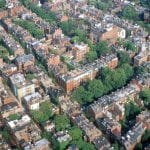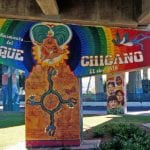I thought I’d take this opportunity to report to you from the front lines of sustainable development. Since September 1996 I’ve been working with Van der Ryn Architects and the Ecological Design Institute, where we get many opportunities to plan and design using the sustainability principles that Urban Ecology has advocated for so long. I’d like to share a few exciting success stories from our work.
The Real Goods Solar Living Center in Hopland, completed in June 1996, is northern California’s first major example of straw bale construction. The building needs no mechanical heating or cooling and remains comfortable year-round in a hot climate. It produces its own energy via photovoltaics on site, has a constructed wetlands for treatment of parking lot runoff, and features productive landscaping of fruit trees and grape arbors. We used many salvaged, recycled-content, or sustainably harvested materials in the building’s construction. In one year, Real Goods has had tens of thousands of visitors from all corners of the world, and has doubled its sales projections.
From a community planning perspective, we participated with a team of professionals and a very committed community group in downtown Albuquerque, New Mexico to develop an innovative plan for a former brownfield site. The plan incorporates urban agriculture, a diversity of affordable housing types, mixed-use amenities including local retail, a cafe and day care, and some light industrial uses. This planning process has been driven by the community, with the full backing of the city, and the 27-acre site will be held in a land trust ensuring that the community retains control. The buildings will be designed to be climate responsive, and we hope to be able to incorporate alternative technologies and materials.
Closer to home, we are in the early stages of developing a plan for a California community that will address the edge between town and farmland in a new way. We’ve developed a concept of permanent organic agriculture with an interior housing cluster utilizing straw bale and alternative construction methods. The landscape design brings back the native patterns of the area and creates green space with a valuable shade canopy. On-site biological wastewater treatment eliminates the need for sewer hookups. The land outside the cluster community will be held in a conservation easement, guaranteeing against future leap-frog and speculative development.
The methods and technologies our society must embrace to move toward sustainability are not all new or technologically innovative. In many cases they are proven and permittable. What is needed is the firm commitment from all of us to push — hard — for change. We need to make sure that communities actively participate in and lead the planning process, that professionals support this leadership with our technical expertise, and that we push the technological envelope because conventional ways don’t work for the long term.
We have the tools to create this change, but must continue to re-educate policy makers and developers. Urban Ecology is doing just this in different ways. Kate White, our Blueprint Project Director is busy initiating a progressive developers’ forum to provide research and materials to developers who want to do high-quality infill development but come up against regressive city planning policies. She’s also investigating a sub-regional agreements project to bring sustainability concepts into the policy arena.
Our Community Design Consulting program is doing well under the able guidance of Project Director Michael Rios. We have agreements to initiate two new projects: a greenway in Richmond and a 16th Street BART plaza redesign in San Francisco. We’re working with local community and youth groups, non-profit housing developers, merchant associations, and city departments, providing a unique, valuable, pro-bono service to these communities.
Rachel Peterson, formerly Community Design Project Director, is our interim Executive Director after Deborah Berman-Santana’s decision to leave in May. Rachel expertly guides our staff, works very well with the Board, and is helping lead the way in our efforts to build a strong organization. Many thanks also to our Development Director Holly Carrington, our Office Manager Kim Traber, our Admininstrative Assistant Jacqueline Wideman, and all our committed and talented volunteers. We are very fortunate so have such a talented staff and member base. Please feel free to call Rachel or myself with any questions, ideas or suggestions!
Sustainably yours,
Andrea Traber





